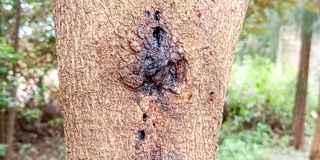Know how to eliminate ambrosia beetle, a deadly enemy of over 100 tree species

A tree trunk attacked by Ambrosia beetles. Globally, the beetle attacks more than 100 species of trees.
What you need to know:
- Globally, they attack more than 100 species of trees, according to Prof Marcus Byrne of the Zoology and Entomology department at South Africa’s Wits University.
- The most common sign of attack is a noodle-like waste and sawdust mixture protruding from the trunk of attacked plants and fine sawdust surrounding the base of trees.
- Ambrosia beetles are mostly attracted to ethanol, a chemical that trees produce when they are stressed.
- Dr Moses Langat, a research scientist at the Royal Botanic Gardens in the UK, is coordinating research on its medicinal benefits.
In December last year, I noticed that several of my Croton megalocarpus trees in Soy, near Eldoret, were wilting.
That time, I didn’t give them much attention because it is normal for trees to shed leaves during the dry season.
Mid this year, the affected trees, which I planted in 2014, died. I found it odd because it was in the middle of the rainy season and they were next to others that looked healthy.
This month during a visit to the farm, I gave some more attention to the dead trees. I noticed that they all had tiny holes in their trunks.
A number of live trees also had these holes. Further research established I was looking at an infestation of Ambrosia beetles.
The beetles are small insects that excavate tunnels in trees in which they cultivate fungal gardens, their sole source of nutrition.
Globally, they attack more than 100 species of trees, according to Prof Marcus Byrne of the Zoology and Entomology department at South Africa’s Wits University.
These include jacaranda, oak, black wattle, olive and even fruit trees like avocado, peach and plum. South Africa has had one of the largest infestations of the beetle, which is said to have originated in Asia.
It has killed hundreds of iconic jacarandas in Johannesburg.
Attracted to ethanol
In Kenya, according to Bernard Kigwa, a research scientist at the Kenya Forestry Research Institute (Kefri), Kitui station, Croton is one of the trees that are susceptible to attack by the beetle, which is usually severe for trees growing in areas of altitudes ranging from 1,300 to 2,100 metres above sea level.
The most common sign of attack is a noodle-like waste and sawdust mixture protruding from the trunk of attacked plants and fine sawdust surrounding the base of trees.
Other signs are small holes in the trunk. On live trees, look for sap leaking out of the tree, stained bark and wilting leaves.
Ambrosia beetles are mostly attracted to ethanol, a chemical that trees produce when they are stressed. They can produce multiple generations each year and decimate large plantations of trees if not checked.
Stanton Gill, an extension specialist in integrated pest management and entomology at the University of Maryland, says the best approach is to prevent attacks.
In a paper titled ‘Ambrosia beetle control and understanding how and why they attack certain plants’, he advises farmers to beware of tree stressors like flooding, drought or pruning injury , which may invite the beetles.
Once they attack, spraying the tree with insecticide may help, Kigwa says.
But this is only in cases where the trees have not been bored by the beetles because once they gain entry, it becomes very difficult to control them.
Spraying them with oil
“In severe infestations in which the trunk of the affected tree has many entry points, you may require to remove the whole tree because the beetles hide inside the wood and continue with their reproduction cycle,” noted Kigwa.
He adds, “Avoid littering the area where the tree was growing with its remnants as this might promote the spread to the remaining unaffected trees.”
Croton megalocarpus has many benefits. Biofuels, cosmetics, fertilisers and livestock feeds are just some of the valuable commercial products produced from its nuts. But there could be even more value in the tree.
Dr Moses Langat, a research scientist at the Royal Botanic Gardens in the UK, is coordinating research on its medicinal benefits.
“We’ll be working to determine if the nuts offer beneficial chemical compounds that could have pesticidal, antifungal, antimicrobial, antimalarial and even anticancer effects,” he says in an article on the Royal Botanic Gardens’ website.
Some farmers traditionally protect their trees from beetles by spraying them with oil pressed from the nuts.
But the best way to prevent ambrosia beetle damage is to maintain proper plant care, including adequate mulching, watering during a drought, and preventing damage to the root system.




